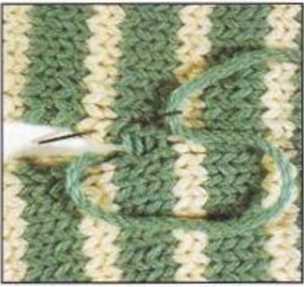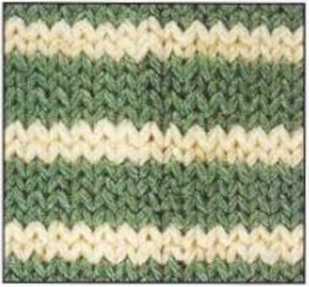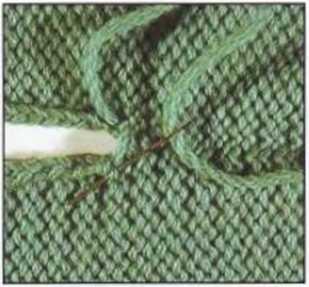112

Invisible Seams to Join Selyedges
The lx*st way to sew side and sleeve seams is with invisible stitches.
You can u»c this stitch to sou pieces worked in srockinettc stitch, revcrsc stockinette, or evcn shaker knittin#—almost invtsibly together. Ofcoursc, you must tir't have perlect edges (sce also sclvedge stitches, pages 26 27).
Bełoro yvm sew the piccos together, błock them and lor them drv under dampcloths (sec pugc 12ł).
To sew the MMins, you need a tapestry or wool noodle. If possiblc, you should sew the pteces together with the same yarn you useJ for knitting. 1 hat works woli tor all smooth ttr only slightly f’u::y yams. When using long mohair yarn or specialty yams with nuhs or fringes, il is hotter to use a smooih vam that matches in color. But do not usc sewinj* threaJ. hecause u does not strctch enough.
Pm the knittcJ picces onto a sutficiently large work area with the right side of the work on top. Always start at the bottom edge and work front right to leń.
Stockinette Stitch Pieces
First sew the seleedge stitches ot the casting-on rows together. To do this, insert the ncedle next to the scleedge sritches, going from bottom to top of one piece to the other. Fhcn catch the first horizonral thread betwecn the schedgc stitch and the knitted ptece of the top piece. On the Kitlom piece, now catch the ńrst and the second horizontai fhreads, then the second and third horizontai threads on the



IOn pieces worked in stockinette stitch, begin sewing with 1 horizontai thread,...
2 ...then catch 2 horizontai threads of the top and bottom pieces each time.
3Because of the offset, even stripes and textured patterns match up perfectly.


*> ...and 1 stitch of the top piece.

IOn pieces worked in reverse stockinetto, only catch 1 stitch
of the bottom piece...
3Aftor tightly pulling the yarn, the seam can hardly be seen.
112
Wyszukiwarka
Podobne podstrony:
mek gt alraune 4 14 WELCOME TO THE COCKS AND DREAMS CLUB... STEP EORWARD, LADIES/ HERE YOU LL
2951?beH0 jpeg i want to hołd hands and waste friday nights with you
The Joy of Half a Cookie Using Mindfulness to Lose Weight and End the Struggle with Food USING MINDF
Finishing Either pin the pieces together, right side to right side, and then sew the seam using
mbs 010 MY BREATHING SYSTEM would die. But few understand how to brcathe, inhale and exhale, corrcct
ape 049 •19 THE SHOULDEK. Front the front horizonlal, swing arms to position shown. and return. This
24 1 (3) sody (make 6) I topwing (make 12) smali rings (■ ch 10. join wilk sl st to form ring. ch 1
mus dev(7) 37 106 St. John St.. Macon, Ga. DEAR MR LIEDERMAN: ... I have buckled d
więcej podobnych podstron